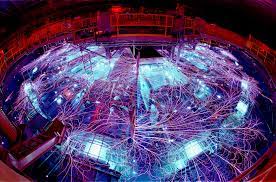Have you ever heard about China’s Artificial Sun? What was the first picture that came to your mind when you got to know about this seeming extraordinary feat? Did you imagine another huge glowing orange glob of fire hoisted in the skies of the Asian nation? Well, if you could not make sense of the viral social media broadcast – which actually sounded like fake news when it broke – here is an opportunity to make sense of it all.
It is important to understand what the artificial sun is about because it might actually turn out to be the central energy source to power our lives on earth in a few years to come.
Meanwhile, what is known as China’s Artificial Sun is the country’s Experimental Advanced Superconducting Tokamak, generally known by its acronym EAST. It is a fusion power machine, which China activated in December 2020 and with it set a new record in experimental energy production. The EAST ran at 216 million degrees Fahrenheit, that is at 120 million degrees Celsius, for a total of 101 seconds. It also achieved the peak temperature of 288 million Fahrenheit or 160 million degrees for 20 seconds. This temperature is even hotter than the sun!
So, what exactly is fusion power? Fusion power is an experimental form of power generation that generates electricity by using nuclear fusion reactions. In a fusion process, two atomic nuclei combine to form a heavier nucleus, while releasing energy. Devices that produce energy in this way are known as fusion reactors. Fusion is the same process that the sun (and stars) produces energy; hence, it is the energy source of the sun. Scientists think it has the potential to provide virtually limitless carbon-free electricity to power our lives on earth. China’s successful experiment has shown that we are now at the threshold of global fusion power usage. And the realisation of such a future means that a net-zero carbon future is possible.
Fusion processes require fuel and a confined environment with sufficient temperature, pressure, and confinement time to create a plasma in which fusion can occur. The combination of these figures that results in a power-producing system is known as the Lawson criterion (which compares the rate of energy being generated by fusion reactions within the fusion fuel to the rate of energy losses to the environment). In the sun, the most common fuel is hydrogen and gravity provides extremely long confinement times that reach the conditions needed for fusion energy production. Proposed fusion reactors generally use hydrogen isotopes such as deuterium and tritium (and especially a mixture of the two), which react more easily than hydrogen to allow them to reach the Lawson criterion requirements with less extreme conditions.
Fusion power promises to provide more energy for a given weight of fuel than any fuel-consuming energy source currently in use. The fuel (primarily deuterium) exists abundantly in the ocean: about 1 in 5600 hydrogen atoms in seawater is deuterium. Although this is only about 0.015%, seawater is plentiful and easy to access, implying that fusion could supply the world’s energy needs for millions of years. Fusion power could be used for so-called ‘deep space’ propulsion within the solar system and for interstellar space exploration where solar energy is not available, including via antimatter-fusion hybrid drives.
As a source of power, nuclear fusion is expected to have many advantages over fission – presently used to generate nuclear energy. These include reduced radioactivity in operation and little high-level nuclear waste, ample fuel supplies, and increased safety. However, the necessary combination of temperature, pressure, and duration has proven to be difficult to produce in a practical and economical manner. Research into fusion reactors began in the 1940s but, to date, no design has produced more fusion power output than the electrical power input.
What is more? Given the potential of fusion to transform the world’s energy industry and mitigate climate change, fusion science has traditionally been seen as an integral part of peace-building science diplomacy. However, technological developments and private sector involvement have raised concerns over intellectual property, regulatory administration, global leadership; equity, and potential weaponisation. Developments from late 2020 onwards have led to talk of a “new space race” with multiple entrants, pitting the US against China. As a matter of fact, there are calls for a global commission to regulate fusion power.
Going forward, what the scientists in China achieved last year is a landmark. Having built a fusion reactor that became the first in the world to reach 100 million degrees Celsius, it was a signal that fusion energy generation was possible. That is nearly seven times hotter than the sun’s core and the temperature at which hydrogen atoms can begin to fuse into helium. The achievement by China’s Institute of Plasma Physics at its Experimental Advanced Superconducting Tokamak is a milestone on the fusion journey and will provide valuable insights for the International Thermonuclear Experimental Reactor project. ITER is a collaboration between the European Union, India, Japan, China, Russia, South Korea and the United States.
At an estimated cost of $25 billion, the consortium is building a prototype fusion reactor, called a tokamak, in southern France. It aims to conduct a first test of super-heated plasma by 2025 and generate first full-power fusion by 2035. Although ITER is the biggest and most expensive fusion project, there are more than a dozen other fusion research initiatives underway. Last year a privately funded UK venture called Tokamak Energy announced its plasma had hit 15 million degrees Celsius for the first time. A collaboration between MIT and the start-up Commonwealth Fusion Systems is designing a fusion reactor capable of producing more power than it consumes. Their research will complement the work done by ITER.
The reality is that the world urgently needs a carbon-free, safe, clean and limitless source of energy to provide cheap electricity. Fusion energy has the potential to meet this need. Japan has pledged to be carbon-neutral by 2050, China by 2060, and the UK has committed to net-zero greenhouse gas emissions by 2050. At the same time, the world’s demand for energy will grow substantially. Increasing electrification generated from carbon-neutral sources will be needed, and this will not be met in the long term without new contributions from fusion energy.
According to a World Economic Forum report, “Carbon-intensive energy sources will produce diminishing amounts of the world’s electricity. Renewable energy can potentially meet a significant proportion of demand, but it cannot guarantee baseloads because of vagaries in the weather and it is less suited to high-density cities. Electricity from nuclear fission currently provides around 10% of the world’s demand. It is estimated that fusion could contribute a similar percentage in the future.”
In my view, the fusion power technology should be in the basket for green technology transfer offer to the developing world, even as the scientific world sells the idea to the United Nations Framework Convention on Climate Change. Definitely, it is the future of clean energy because it is safer than the present nuclear energy with which it shares the same potentials. Moreover, the consensus among world scientists cannot be taken lightly: Although the process still poses great engineering and scientific challenges, fusion offers an almost infinite low carbon energy source in the long term. There is, therefore, an overriding need to continue collaborations at a global scale and also to start early in exploring the process for worldwide fusion energy regulation platform.

 Iran Energy News Oil, Gas, Petrochemical and Energy Field Specialized Channel
Iran Energy News Oil, Gas, Petrochemical and Energy Field Specialized Channel



